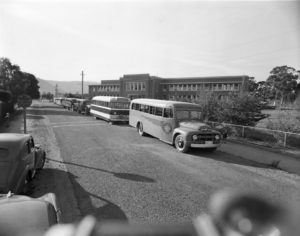 I don’t know about you, but I have been confused about Kamala Harris’s accusation on the debate stage during the first Democratic debate in June that Joe Biden did not support busing during the 1970s and 1980s. I heard Harris accused in the media after the debate of distorting the facts to bolster her political campaign. I also heard Biden deny repeatedly that he had been cozy with Southern segregationists and had not supported busing. He proclaimed over and over again that he had supported civil rights during that period. But something didn’t seem to add up. I am always suspicious about attempts to discredit powerful women. I wondered if Harris was getting the “how dare a woman show ambition and strength” treatment. And, of course, I wondered how race was playing into this whole dynamic. How could it not? As a black woman, was Harris experiencing a double whammy of backlash based on both race and gender?
I don’t know about you, but I have been confused about Kamala Harris’s accusation on the debate stage during the first Democratic debate in June that Joe Biden did not support busing during the 1970s and 1980s. I heard Harris accused in the media after the debate of distorting the facts to bolster her political campaign. I also heard Biden deny repeatedly that he had been cozy with Southern segregationists and had not supported busing. He proclaimed over and over again that he had supported civil rights during that period. But something didn’t seem to add up. I am always suspicious about attempts to discredit powerful women. I wondered if Harris was getting the “how dare a woman show ambition and strength” treatment. And, of course, I wondered how race was playing into this whole dynamic. How could it not? As a black woman, was Harris experiencing a double whammy of backlash based on both race and gender?
For all these reasons, I found it very helpful and clarifying to read an article by Nikole Hannah-Jones in the New York Times. Hannah-Jones explains that Harris was right and provides helpful history and perspective. For example, Hannah-Jones identifies and explores the following race-neutral myths that have become the story we tell to allow people to pretend that the opposition to school desegregation was about riding a bus. Here are some of these myths:
- The Supreme Court decision Brown v. Board of Education failed to desegregate schools.
- Busing was a failed strategy.
- Busing caused “white flight” in cities.
- White opposition to busing was not about race but maintaining neighborhood schools.
- Northern whites thought Brown v. Board of Education applied to only Southern states.
Here are the facts about what really happened, according to Hannah-Jones:
- Busing became a race-neutral code word for court-ordered school desegregation. School busing has been around since 1920, but only when it became a tool for integration did it become reviled. White communities blamed the act of busing for their resistance to integration, which allowed them to deny the role of racism in their protests.
- Biden worked with Southern senators to pass a bill to ban busing for integration as part of the systematic anti-integration campaign known as Massive Resistance, waged by the white South against the Supreme Court decision.
- The federal government got involved in enforcement only when local and state governments openly rebelled against the Supreme Court and refused to take any steps toward desegregation.
- Busing became a vehicle of integration because, due to residential policies resulting in segregation, black and white people did not live in the same neighborhoods.
- Biden did originally support busing for integration in 1972 but then flipped his position in 1975 and teamed up with ardent segregationists.
- Politicians and the media blamed white flight from cities on busing, but studies show that cities with large black populations suffered from white flight whether they instituted busing or not.
- When Northern states realized that Brown v. Board of Education also applied to them, support for Brown’s integration mandate plummeted.
The truth about integration is not the story we usually hear:
- Busing as a tool of desegregation was very successful in the South. The South went from the most segregated region of the country for black children to the most integrated—which is still true today.
- School desegregation significantly reduced the test-score gap between black and white children.
- Research by Rucker C. Johnson of the University of California, Berkeley, found black children in integrated schools were more likely to graduate from high school, get out of poverty, earn more as adults, not go to jail, and actually live longer.
- Data from the Education Department shows that still today, the whiter the school, the more resources it has.
In conclusion, busing did not fail and Harris was right. We need to clear away the myths and propaganda we have been fed to see the truth so that we can see the candidates clearly.
Photo courtesy of Tasmanian Archive and Heritage Office (CC BY 2.0)
Anne,
Thanks for doing the research and analysis to sort this out. I was confused too.
It is SO important to get behind the sound bites. Thank you, Anne, for this level of historical information and plain old *facts.* And, in this example as in so many, issues of race pervade even though most white Americans swear “it’s not about race!”
Kamala Harris lives at the intersection of racism and sexism – and is a strong, powerful woman. Parts of her record I have real issues with, but she is one of my top two choices as of now. I’ll be curious (and not surprised but disappointed) to see attacks on her sharpen as she moves towards being a/the front-runner. I dread it. I also think she is tough and can do it. But getting to the facts will help us all.